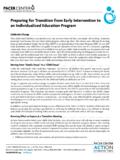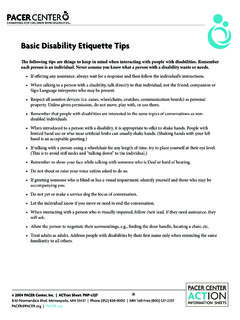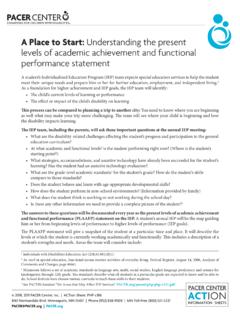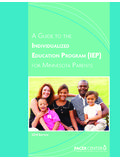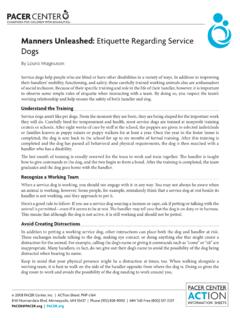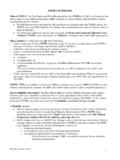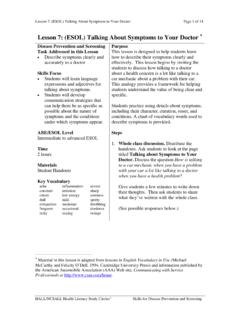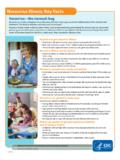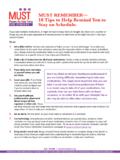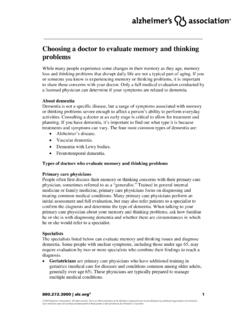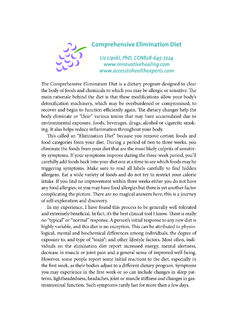Transcription of Ten Tips That May Help Your Child’s Transition to …
1 2016, 2012, 2005 PACER Center, Inc. | ACTion Sheet: PHP-c1078161 Normandale Blvd. Minneapolis, MN 55437 | Phone (952) 838-9000 | MN Toll-Free (800) | CENTERACTIONINFORMATION SHEETSTen tips That May help your child s Transition to AdulthoodPlanning for your child s Transition from adolescence to adulthood is one of the most important things you can do to pave the way to a successful future. In Minnesota, Transition planning and services required by the Individualized Education Program (IEP) begin when your child with a disability is in the ninth grade or before if needed. You and your son or daughter will start learning new skills side-by-side. As your youth begins to take on more responsibility, you will find new ways to provide support. Regardless of physical or cognitive ability, your youth can play an active role in the Transition journey, and in determining his or her own life, if you provide encouragement and guidance along the way.
2 As you and your youth plan for the future, consider these tips for a successful Transition . You can help your son or daughter: 1. Develop self-determination and self-advocacy skills All young people need a strong sense of their strengths, abilities, interests, and values. If students have a disability, they should also be aware of how it might affect them at work, in the community, and in their educational pursuits, and they should be able to explain it to others. Helping youth speak with understanding about their disability is one step to empowering them as they take on adult responsibilities of work, education, and independent living. Many young adults know that they have received special education services but do not understand why. They may not have realized the supports they need in employment or independent living to be successful, which may cause unnecessary frustration and low self-esteem.
3 Transition is a time to explore how youth will talk about their disability in different settings and ask for any support or accommodation they will need. You can make sure your youth has a variety of opportunities to learn and practice self-advocacy and self-determination skills in the classroom, at student work sites, and in the community. The IEP could provide some of these opportunities. It is important for students to develop the skills to talk about their disability before they enter postsecondary education and the workforce. In order to be protected from discrimination under the Americans with Disabilities Act, the individual must disclose information about his or her disability to an employer or educational institution and explain the need for specific accommodations. 2. Expand social and community support networks Social and community networks are more than fun; they are important tools that help connect people to their community and provide a wider network of support.
4 As children with disabilities become adults with disabilities, they may need support from a variety of sources. Start now to develop helpful social and community support networks for your youth. Who do you know in your family, social group, professional circle, faith-based community, or other area who could help provide social, recreational, work, or volunteer experiences for your young adult? Transition planning that addresses opportunities for social relationships and recreation can build a bridge to new friendships, potential employment opportunities, and a wide range of natural community supports. 2016, 2012, 2005 PACER Center, Inc. | ACTion Sheet: PHP-c107, Ten tips That May help your child s Transition to Adulthood8161 Normandale Blvd. Minneapolis, MN 55437 | Phone (952) 838-9000 | MN Toll-Free (800) | contacting adults in the community who have the same disability as your son or daughter to learn what kinds of supports they use.
5 Peer mentoring opportunities are sometimes available through disability organizations including Centers for Independent Living ( ). Parents may feel there is a risk in allowing their son or daughter to develop new relationships and friendships, but building natural and shared relationships is an important first step for all young Build a work resume Many young people struggle to find work experiences that help them compete in the job market. Summer jobs, helping neighbors, and volunteering are great solutions. Many summer jobs and volunteer experiences can be found through your network of friends, family, and social organizations. Traditional summer jobs, such as mowing lawns or dog walking, can be described on r sum s as self-employment enterprises if your youth creates business cards and flyers on a computer or demonstrates other business skills.
6 By taking part in a variety of community activities, young adults can develop employment and social skills while building a resume and increasing their network of potential employer contacts. your son or daughter is more likely to find future paid employment if he or she demonstrates interests, abilities, initiative, and dedication to work through community and volunteer activities. The participation of a parent, friend, or group of peers may help enrich the experience. 4. Learn soft employment skills In addition to the work skills people need for their jobs, they also need soft skills. These include such things as being able to accept direction, return from breaks on time, deal with conflict, have the confidence to make decisions, and engage in appropriate personal communication. Soft skills also include dressing properly for the workplace, focusing on the job at hand, asking for help when needed, calling in when ill, and using typical responses such as good morning and thank you.
7 You can help your young adult develop these skills by teaching them at home, and then providing opportunities for practice at school and in social Practice money management skills Financial education is an important part of Transition . Children need the self-determination skills developed through saving, spending, gift giving, and budgeting. Parents can begin by opening a savings account and taking their son or daughter to the bank regularly to deposit part of his or her allowance, earnings, or cash gifts so that he or she becomes familiar with financial institutions. Learning how to use an ATM card for saving and withdrawals may be appropriate for many youth. your child can practice his or her skills if you include him or her in budget decisions concerning birthday parties, holiday dinners, or family vacations. As youth Transition to independent living and adult responsibilities, their previous experience with spending and saving will allow them to participate more fully in their own quality of-life decisions.
8 If your son or daughter qualifies (or may qualify as an adult at the age of 18) for State or Federal benefits due to disability and limited financial resources, planning ahead is important. The Minnesota Disability Linkage line at 1-866-333-2466 and the Disability Benefits 101 link at provide information on benefit programs, work incentives, and benefit Connect with adult service providers Upon graduation from high school, IDEA special education services end. This means that the IEP team will no longer be available to coordinate disability-related services that your child may need, such as 2016, 2012, 2005 PACER Center, Inc. | ACTion Sheet: PHP-c107, Ten tips That May help your child s Transition to Adulthood8161 Normandale Blvd. Minneapolis, MN 55437 | Phone (952) 838-9000 | MN Toll-Free (800) | , transportation, physical or speech therapy, and job development services.
9 All of these services and others, if available, will very likely be provided by different agencies, each with its own application process and eligibility standards. Governmental programs, such as vocational rehabilitation services, supports for people with intellectual or developmental disabilities, public mental health services, and supplemental security benefits, all provide some services to people with disabilities who meet their requirements. Young adults, to the extent they are able, and their families will have to take responsibility for evaluating, applying for, and coordinating these services. Confidentiality policies and age of majority (age 18 in Minnesota) may establish a barrier between parents and service professionals. The IEP team can help families determine what adult services are available, anticipate eligibility issues, and initiate connections.
10 It is important that these connections are established before graduation whenever possible. 7. Explore housing options While some young adults may stay on in the family home at least for the short term, others may live in residential housing with services, cooperative housing, a dormitory at an educational institution, an apartment with or without roommates, or they may own a home. Different types of housing and supervision oversight might be appropriate during different periods of your young adult s life. The choice of housing is often dependent upon the community, the family s resources, and support system. There are both federal and state subsidized housing programs. If your son or daughter receives county services, your social worker can help you explore options. Networking with other families may provide valuable suggestions and contacts.


